CSV (Comma Separated Values) file is a tool used to store and exchange data in a simple and structured format. It is a plain text file that contains data separated by commas, where each line represents a record and each field is separated by a comma. CSV files are widely used in data analysis, data migration, and data exchange between different software applications. The CSV file format is easy to read and write, making it a popular choice for storing and exchanging data. It can be opened and edited using any text editor or spreadsheet software, such as Microsoft Excel or Google Sheets. CSV files can also be imported and exported from databases, making it a convenient tool for data management. CSV files are commonly used for storing large amounts of data, such as customer information, product catalogs, financial data, and scientific data. They are also used for data analysis and visualization, as they can be easily imported into statistical software and other data analysis tools. Overall, the CSV file is a simple and versatile tool that is widely used for storing, exchanging, and analyzing data.
BigQuery is a cloud-based data warehousing and analytics platform that allows users to store, manage, and analyze large amounts of data in real-time. It is a fully managed service that eliminates the need for users to manage their own infrastructure, and it offers a range of features such as SQL querying, machine learning, and data visualization. BigQuery is designed to handle petabyte-scale datasets and can be used for a variety of use cases, including business intelligence, data exploration, and predictive analytics. It is a powerful tool for organizations looking to gain insights from their data and make data-driven decisions.
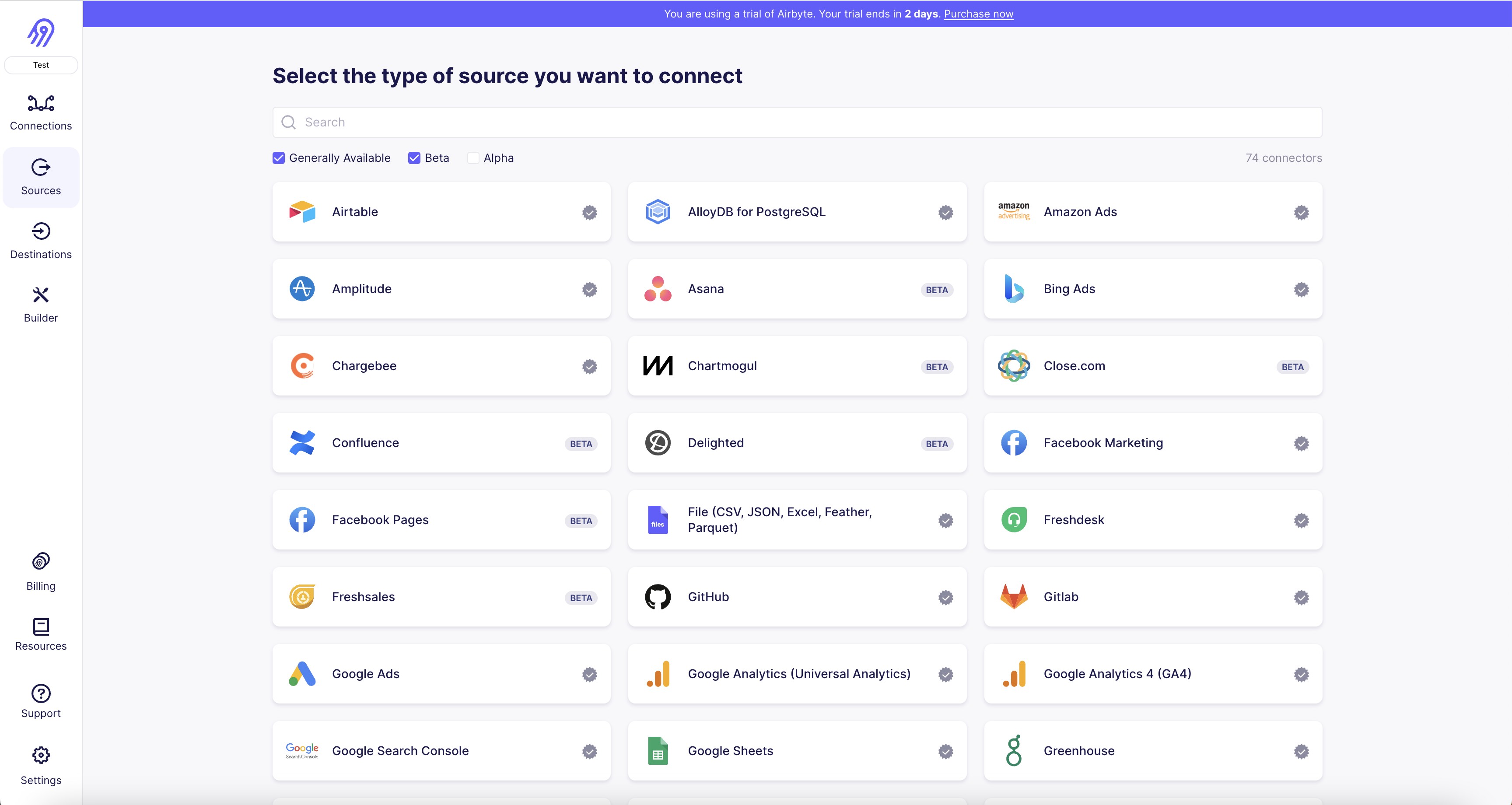
1. Open the Airbyte platform and navigate to the "Destinations" tab on the left-hand side of the screen.
2. Click on the "CSV File" destination connector.
3. Click on the "Create new connection" button.
4. Enter a name for your connection and select the workspace you want to use.
5. Enter the path where you want to save your CSV file.
6. Choose the delimiter you want to use for your CSV file.
7. Select the encoding you want to use for your CSV file.
8. Choose whether you want to append data to an existing file or create a new file each time the connector runs.
9. Enter any additional configuration settings you want to use for your CSV file.
10. Click on the "Test" button to ensure that your connection is working properly.
11. If the test is successful, click on the "Create" button to save your connection.
12. Your CSV File destination connector is now connected and ready to use.

1. First, you need to have a Google Cloud Platform account and a project with BigQuery enabled.
2. Go to the Google Cloud Console and create a new service account with the necessary permissions to access your BigQuery data.
3. Download the JSON key file for the service account and keep it safe.
4. Open Airbyte and go to the Sources page.
5. Click on the "Create a new source" button and select "BigQuery" from the list of available sources.
6. Enter a name for your source and click on "Next".
7. In the "Connection Configuration" section, enter the following information:
- Project ID: the ID of your Google Cloud Platform project
- JSON Key: copy and paste the contents of the JSON key file you downloaded earlier
- Dataset: the name of the dataset you want to connect to
8. Click on "Test Connection" to make sure everything is working correctly.
9. If the test is successful, click on "Create Source" to save your configuration.
10. You can now use your BigQuery source connector to extract data from your dataset and load it into Airbyte for further processing.
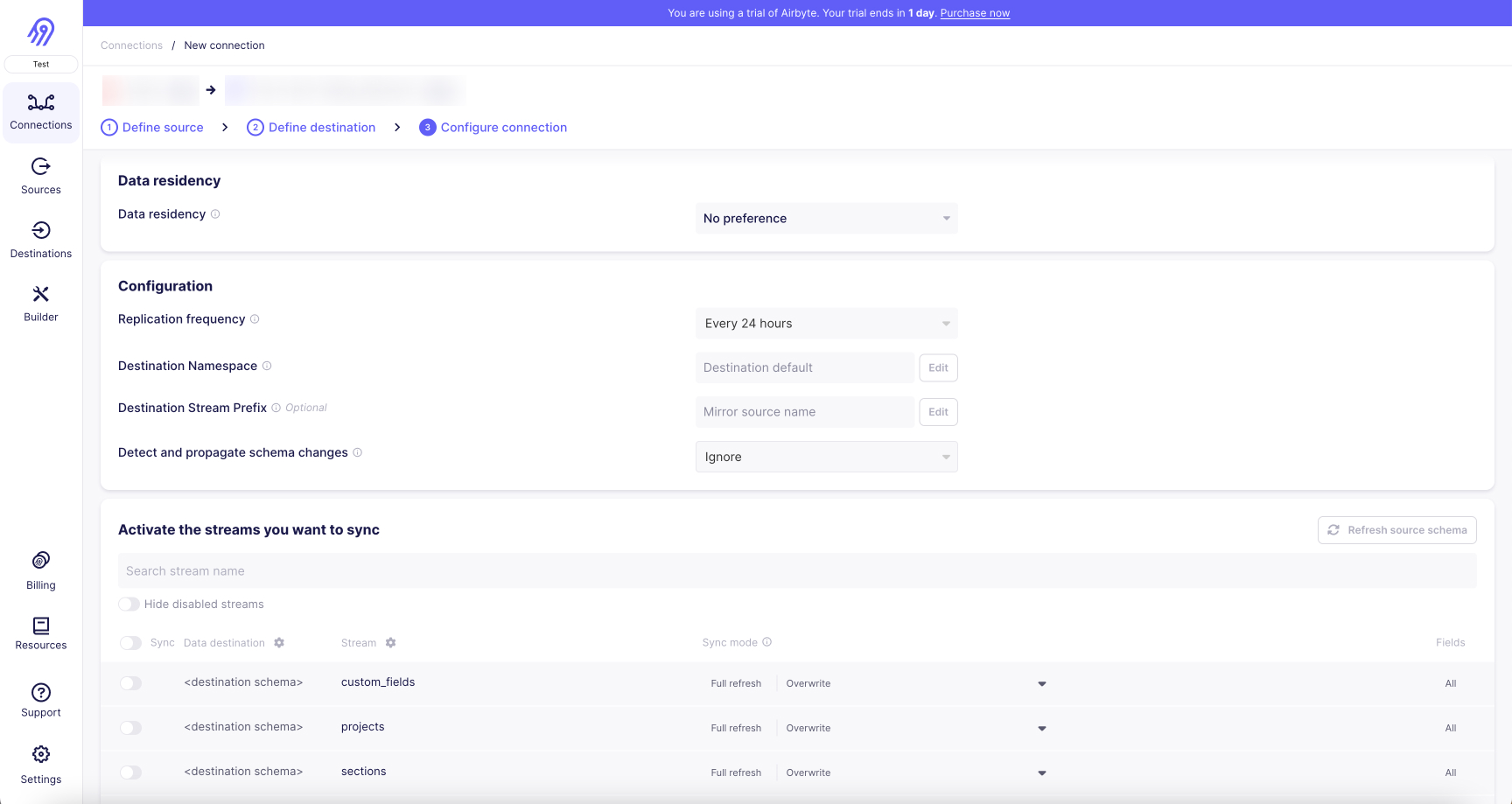
With Airbyte, creating data pipelines take minutes, and the data integration possibilities are endless. Airbyte supports the largest catalog of API tools, databases, and files, among other sources. Airbyte's connectors are open-source, so you can add any custom objects to the connector, or even build a new connector from scratch without any local dev environment or any data engineer within 10 minutes with the no-code connector builder.
We look forward to seeing you make use of it! We invite you to join the conversation on our community Slack Channel, or sign up for our newsletter. You should also check out other Airbyte tutorials, and Airbyte’s content hub!
What should you do next?
Hope you enjoyed the reading. Here are the 3 ways we can help you in your data journey:



CSV is a popularly used data format for storing structured or unstructured data in a tabular format or within a plain text file separated by commas. It is used by businesses to facilitate data exchange and storage, as CSV offers a lightweight and human-readable way to represent data. CSV is commonly employed for tasks such as data import or export, backups, sharing between different applications, and as a medium format for analysis. With benefits, it also has some limitations, like a lack of support for data types, relationships between data, and nested data. However, by moving data from CSV to BigQuery, you can address these limitations and unlock a multitude of benefits.
Let’s learn how!
What is BigQuery?

Developed by Google, BigQuery is a fully managed and serverless enterprise-ready data warehouse and analytics platform. With BigQuery, you can store, analyze, and gain valuable insights from your data. This makes it a versatile tool for data-driven organizations.
By moving data from CSV to BigQuery, you can streamline your data management and analysis processes. The other advantages include:
- BigQuery is a highly scalable and distributed data warehouse. This makes it suitable to handle enormous amounts of data.
- The serverless architecture of BigQuery ensures that you don’t need to worry about managing infrastructure. This allows you to completely focus on data analysis.
- BigQuery supports standard SQL Queries. If your team is familiar with SQL, you can quickly use it for complex queries and reporting.
- Bigquery seamlessly integrates with other Google Cloud services. This includes Cloud Storage, Dataflow, and Data Studio. This enables you to create an ecosystem that simplifies data management.
Why use Airbyte to Upload CSV Data to BigQuery?
Some key features of Airbyte include:
- Airbyte provides an intuitive interface for importing data, allowing you to interactively configure load options and monitor the process. Get started with Airbyte for free.
- It offers a growing library of 350+ extensive source and destination connectors.
- Based on configuration settings, Airbyte can automatically discover and infer the source schema changes.
- Using Airbyte, you can establish a Change Data Capture (CDC) pipeline based on logs without the requirement to parse logs manually.
- Airbyte allows users to apply transformations using a web-based interface, making it accessible to non-technical users.
- It supports incremental data synchronization, enabling efficient data replication between various systems.
- Being open-source, Airbyte has an active community of developers who contribute to its development and offer support through forums.
Replicate Data from CSV to BigQuery Using Airbyte
Airbyte is an open-source data integration platform. It is designed to facilitate the collection and movement of data from various sources to different destinations. Its destinations include popular databases, data warehouses, cloud services, APIs, and more.
Apart from a wide range of connectors, what makes Airbyte notable is its support for real-time data synchronization. This feature allows you to quickly make decisions based on the most up-to-date data.
Let’s understand how to create a CSV to BigQuery ETL pipeline using Airbyte UI.
Prerequisites
- A CSV file hosted on AWS S3, GCS, HTTPS, or an SFTP server.
- GCP project in Google Cloud Console.
You would need a BigQuery dataset in your GCP project to load CSV file data. To create a dataset and a table within a dataset, follow the steps mentioned below:
- Log into Google Cloud Console > Create a project > Open BigQuery.
- In the BigQuery, select the project where you want to create the dataset.
- Click on the Create dataset button and provide a unique Dataset ID, Dataset location, description, and set access control for the dataset.
- After configuring the dataset details, click Create Dataset to create a new dataset.
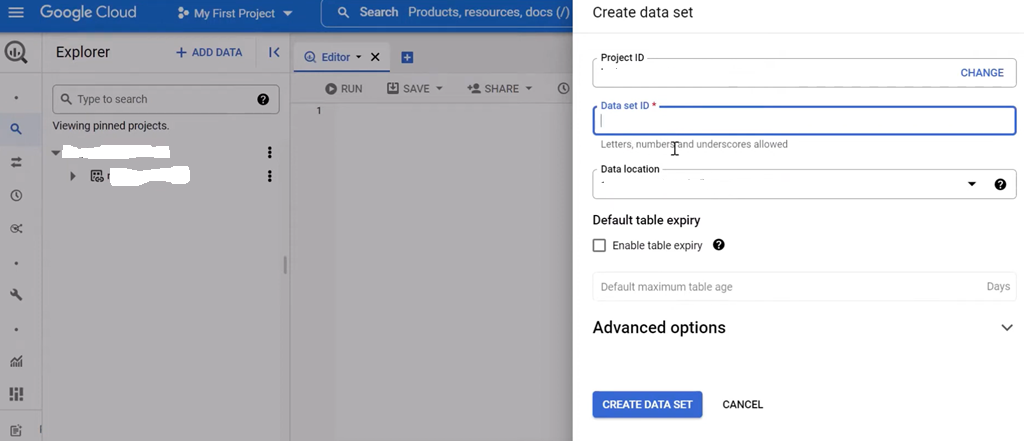
- Open the dataset that you created and click on the Create Table button to create a new table where you’ll be storing CSV file data.
Step 1: Configure a CSV Source in Airbyte
- Sign up for Airbyte Cloud or deploy Airbyte OSS. After successful login, select Sources present on the Airbyte dashboard.
- In the Search bar, type CSV and select the File (CSV, JSON, Excel, Feather, Parquet) connector.
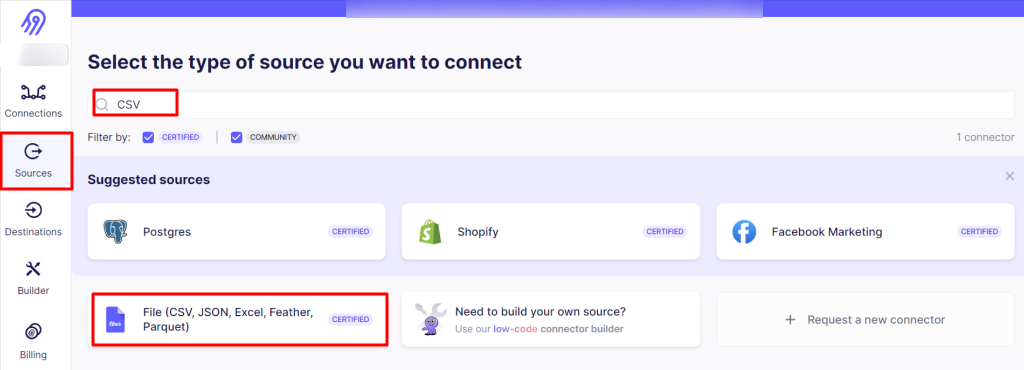
- In the Create a source section:
- Enter a Source name of your choice.
- In the Dataset Name field, enter the name of the target table where you want to replicate the CSV file.
- Select the File Format as CSV from the drop-down.
- Choose the Storage Provider from the drop-down and configure the provider-specific fields.
- Enter the URL path of the CSV file to be replicated in the URL field.
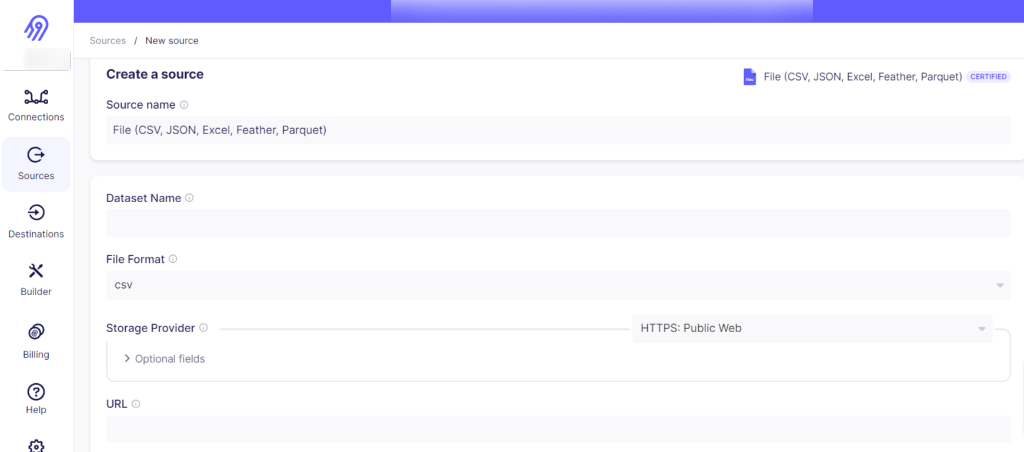
- Once you’ve filled in all the configuration fields, click on Set up source.
- Now, Airbyte will start testing your connection. If all the fields are entered correctly, you’ll receive a connection successful message.
- For a comprehensive understanding of each field, you can refer to the Airbyte File source connector.
Step 2: Configure a BigQuery Destination in Airbyte
- To set BigQuery as your destination in Airbyte, go back to the dashboard and select Destinations.
- Search BigQuery connector in the Search bar and select the connector.
- Enter the name for the BigQuery connector in the Destination name field. In the Connection section, enter your Google Cloud Project ID, Dataset location, Default Dataset ID, Location Method, Service Account Key JSON, GCS Bucket Name, and GCS Bucket Path.
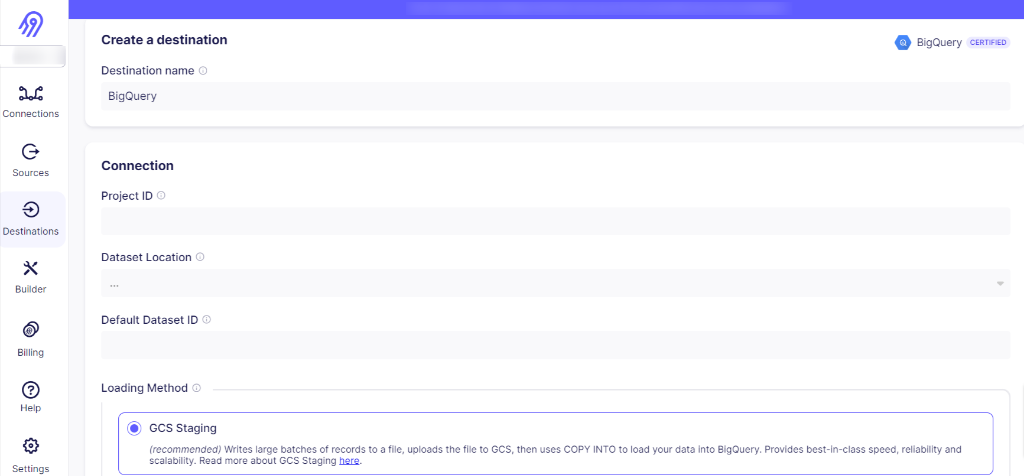
- Click on the Set up Destination button, and Airbyte will initiate to test your destination connection.
- If you find any of the configuration fields unclear, you can refer to Airbyte’s BigQuery setup guide for clarification.
Step 3: Create an Airbyte Connection
- Now go to the dashboard and select Connections from the left-side pane to establish a connection between CSV and BigQuery. Click on Create a new Connection.
- Next, choose the CSV File source you’ve recently created and repeat the same process for the BigQuery destination.
- Provide the new Connection Name and set the Replication frequency. You can change the frequency depending on your requirements.
- On the same page, you can select the Sync mode for your source files. If you aren’t sure about which replication or sync mode to choose, refer to the replication modes in Airbyte. The image below illustrates the configuration steps within Airbyte.

Step 4: Review Data in BigQuery
Once you start the first sync, your data from CSV will be replicated to BigQuery. After a successful sync, you should be able to see your CSV file data migrated in the BigQuery tables.
This approach provides a user-friendly way to ingest and work with CSV data in BigQuery in real time.
Manual Approach to Add CSV Data to BigQuery
To load CSV data from Cloud Storage into a new BigQuery table, you have multiple options available, including:
- Using the BigQuery Console,
- bq command line tool,
- Google Cloud’s API,
- Programming languages like Python, Ruby, Java, C#, Go, Java, Node.js, PHP, and Ruby.
Using the BigQuery Console
- To begin with CSV to BigQuery data integration using BigQuery console, sign in to your Google Cloud account.
- If you haven’t already created a dataset in BigQuery, you can create one within your BigQuery project.
- Once your dataset is ready, select it, and then create a new table within the dataset to copy CSV file data.
- In the Create Table panel, choose to create a table from an uploaded CSV file. You can either upload the CSV file from your local machine or specify the Cloud Storage file path. Define the table schema and configure other settings like partitioning and clustering.
Using the bq command-line Tool
You can manually migrate data from CSV to BigQuery using the bq load command line tool. This assumes you have the Google Cloud SDK (gcloud) installed and properly configured.
First, ensure your CSV file is prepared with the data you want to load into BigQuery, including a header row with column names. You can upload a CSV file to the GCS for simpler access. The other way is using the gsutil command to copy the file to a GCS bucket.
The syntax to copy CSV files stored in your local machine to the GCS bucket is as follows:
Next, use the bq load command to load your CSV data into the BigQuery table. Specify the target dataset and table, as well as the GCS location of your file. You can also set additional options, such as defining the schema or delimiters as needed.
Replace the required fields and execute the command. Monitor the load job’s status with the bq show command.
While the manual approach seems simple, it can be time-consuming and burdensome due to the need for meticulous configuration and the potential for human error. We recommend using a real-time and reliable solution like Airbyte.
Wrapping up
Moving data from a CSV file to a robust warehouse like Google BigQuery can streamline your decision-making journey, facilitating data analysis and informed choices.
This article taught you how to implement an ELT pipeline from CSV to BigQuery quickly. This streamlined approach simplifies the process of capturing and loading CSV data to BigQuery.
You can quickly participate in discussions on Airbyte’s community Slack channel, where you can engage with a thriving community of data professionals, share your insights, and collectively contribute to the success of diverse projects.
What should you do next?
Hope you enjoyed the reading. Here are the 3 ways we can help you in your data journey:



Should you build or buy your data pipelines?
Download our free guide and discover the best approach for your needs, whether it's building your ELT solution in-house or opting for Airbyte Open Source or Airbyte Cloud.

.png)
